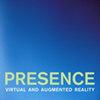NaviCam:增强现实的放大镜方法
IF 0.7
4区 计算机科学
Q4 COMPUTER SCIENCE, CYBERNETICS
引用次数: 113
摘要
当前的增强现实(AR)系统并不是为我们的日常生活而设计的。头戴式透明显示器太笨重,在日常生活中看起来太不寻常。位置跟踪设备有限的可扩展性限制了AR在非常有限的环境中的使用。本文提出了一种不同的方式来实现可在开放环境中使用的AR,通过引入ID感知和手持视频透明显示器的概念。与其他使用头戴式或平视显示器的AR系统不同,我们的方法结合了掌上电脑大小的显示器和小型摄像机。用户通过显示设备看到真实世界,并添加了计算机增强信息。我们称这种配置为放大镜方法。与传统的平视或头戴式配置相比,它有几个优点。其主要优点是使用者不需要佩戴任何笨重的头饰。用户可以像放大镜一样轻松移动显示设备,比较真实图像和增强图像。摄像机还可以获取与现实世界有关的信息。该系统通过读取识别(ID)标签来识别视频图像中的真实物体。基于识别的ID标签,系统检索并向用户显示有关现实世界对象的信息。基于我们提出的概念的原型手持设备被称为NaviCam。我们描述了几种潜在的应用。我们对NaviCam的实验显示了我们的可视掌上显示器的巨大潜力。它比平视配置要快得多,而且测试人员给它的主观评分也更高。本文章由计算机程序翻译,如有差异,请以英文原文为准。
NaviCam:A Magnifying Glass Approach to Augmented Reality
Current augmented reality (AR) systems are not designed to be used in our daily lives. Head-mounted see-through displays are too cumbersome and look too unusual for everyday life. The limited scalability of position-tracking devices limits the use of AR to very restricted environments. This paper proposes a different way to realize AR that can be used in an open environment by introducing the concept of ID awareness and a hand-held video see-through display. Unlike other AR systems that use head-mounted or head-up displays, our approach employs the combination of a palmtop-sized display and a small video camera. A user sees the real world through the display device, with added computer-augmented information. We call this configuration the magnifying glass approach. It has several advantages over traditional head-up or head-mounted configurations. The main advantage is that the user is not required to wear any cumbersome headgear. The user can easily move the display device around like a magnifying glass and compare real and augmented images. The video camera also obtains information related to real-world situations. The system recognizes real-world objects using the video images by reading identification (ID) tags. Based on the recognized ID tag, the system retrieves and displays information about the real-world object to the user. The prototype hand-held device based on our proposed concept is called NaviCam. We describe several potential applications. Our experiments with NaviCam show the great potential of our video see-through palmtop display. It was significantly faster than a head-up configuration, and its subjective score from testers was also higher.
求助全文
通过发布文献求助,成功后即可免费获取论文全文。
去求助
来源期刊
CiteScore
2.20
自引率
0.00%
发文量
8
审稿时长
>12 weeks

 求助内容:
求助内容: 应助结果提醒方式:
应助结果提醒方式:


